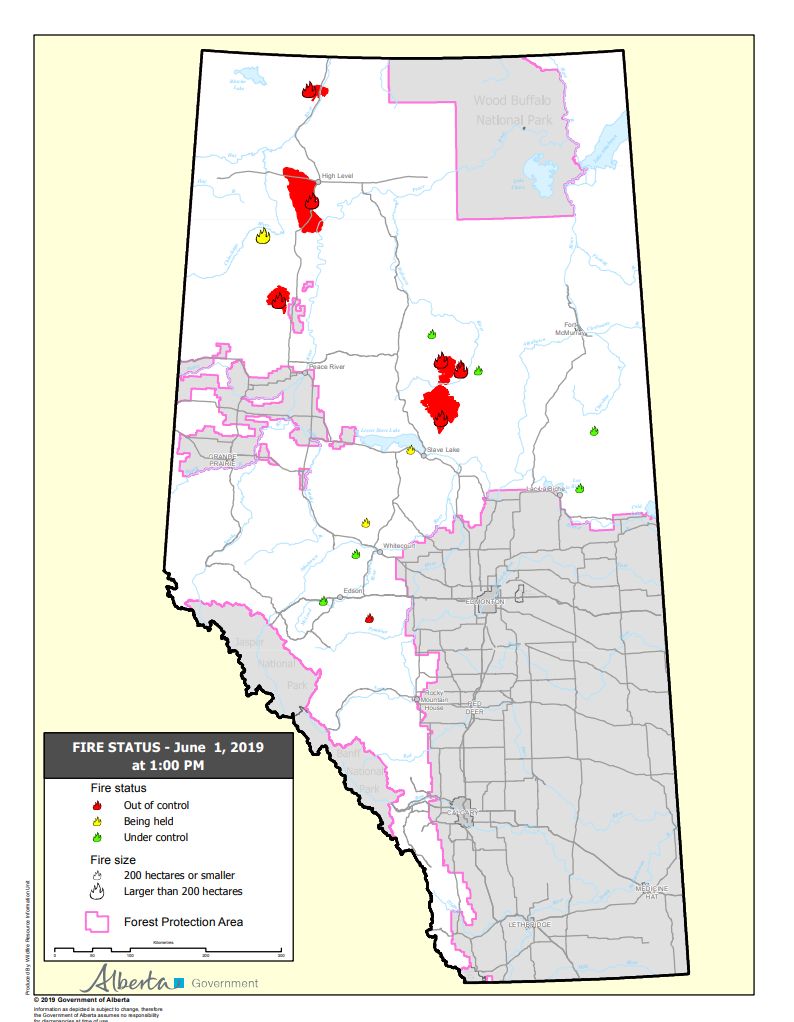The weather will be the number one concern near Slave Lake on Saturday, as a nearby wildfire experienced some growth overnight.

Slave Lake Mayor Tyler Warman said Saturday morning the wildfire — formerly the Maria Lake Wildfire — remained about 35 kilometres north of the town and approximately 23 kilometres from Marten Beach.
Slave Lake residents remained on an eight-hour evacuation alert Saturday, which Warman didn’t anticipate would change any time soon. Residents from Marten Beach remained on mandatory evacuation order.
WATCH: ‘Lightning, wind’ will tell the story of where Slave Lake wildfire will go

While the southeast winds are working in their favour, Warman said the main concern for fire crews on Saturday will be lightning.
Just after 1:45 p.m. Saturday, Environment Canada issued a severe thunderstorm warning for Slave Lake, and a few surrounding areas.
A line of severe thunderstorms was coming through the area from Swan Hills, capable of producing strong wind gusts, heavy rain and up to nickel-sized hail, according to the weather agency. The warning was downgraded to a watch just after 2 p.m.
“We do anticipate some moisture in the area today. Not significant enough to get excited, but with it comes lightning and we’re already seeing some lightning on the north end of the fire and there was a startup near Loon last night that fire crews are working on,” he said around 9:30 a.m.
“The biggest concern moving forward is any new starts would pull additional resources, so hopefully the wind continues to work in our favour.”

Get daily National news
The fire was also experiencing some of its own weather patterns, Warman explained, with high fuel sources and some backburning occurring.
“Basically, the fire jumps backwards instead of forwards. It isn’t significant at this point, but it definitely causes some concern… which is why we keep the eight-hour evacuation order in place.”
As of Saturday morning, there were about 40 aircraft and 300 personnel fighting the wildfire. Warman said 24 water tanks containing more than 400,000 gallons of water have been set up in strategic spots throughout the community, should they have to use them.
Wildfire information officer Lynn Daina said wind gusts of up to 40 kilometres an hour were expected Saturday afternoon, with a shift in the wind direction possible. She said if the winds continue to push the fire to the west, fire crews won’t be in bad shape. However, if the winds shift to come from a southwestern direction, that could cause growth on the eastern perimeter of the fire, which could be problematic for the community of Wabasca.
Daina said crews will be focused on building a fire guard between the wildfire and the community.
“That is our No. 1 focus for today,” she said. “We are working on structure protection, assisting the county and MD with sprinkler protection. We’re working on a dozer guard, which means we’re going to be scraping the forest away from the perimeter of the current fire edge, giving it a fire break.”
Warman said he has been in regular contact with the province and said calls have gone out for international firefighting resources.
On Friday, Federal Public Safety Minister Ralph Goodale said the military will be ready to offer assistance to Alberta’s wildfire situation.
A spokesperson with the Canadian Armed Forces said Saturday that troops are ready to assist with air and ground evacuations. The CAF said it is working with the province to determine where and when resources are required.
Soldiers based out of CFB Edmonton are on eight-hour notice to move, should they be called in, Major Vincent Bouchard told Global News. Two CH-146 Griffons were also placed on standby.
Warman didn’t anticipate too many of those resources ending up in his town given the current situation.
“I wouldn’t expect to see a mass presence on that at the moment,” he said Saturday.
“Still on alert but I think we’re a little more comfortable than we were on Thursday morning. But lighting, I think, will be the one to watch over the next day or two.”
There is another out-of-control wildfire burning in the area, just north of the main fire. Daina said there is a chance the wildfires could merge into one, but added it wouldn’t threaten any homes or communities.
“When they join, that gives us four flanks to work with rather than the six that we have right now,” she explained.
“Joining those two fires together is (in) some ways easier to manage the perimeters on the east and the west and not worry about what’s going on in the centre. There are no values at risk in play right there.”
As of 10 a.m. Saturday, there were 24 wildfires burning in Alberta, eight of which were out of control.
As of 5 p.m. Friday, approximately 11,000 people have been forced from their homes in northern Alberta due to wildfires.
Here is a look at the current situation with the four largest, most serious wildfires:
- Chuckegg Creek wildfire, southwest of High Level, is about 280,000 hectares
- Jackpot Creek wildfire, approximately 11 km north of Lutose, is about 24,700 hectares
- McMillan Wildfire Complex, southwest of Bigstone Cree Nation, is over 178,000 hectares
- Battle Wildfire Complex in Peace River is over 52,600 hectares
For wildfire updates as they happen, download the Alberta government’s Alberta Wildfire app for iOS and Android.












Comments